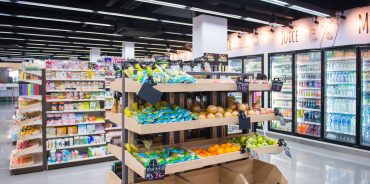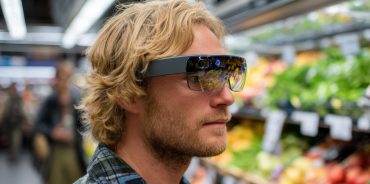Digital signage and the new age of store media
In the wake of huge growth in online grocery over the past year and a half, it can be easy to forget that the store is the place that most people do their shopping – and likely will be for generations to come.
While it’s crucial that we don’t ignore the fact that more people are shopping for groceries online – something that most Retailers would find impossible due to the profitability challenge that this shift presents – we also can’t lose sight of just how important physical stores continue to be. And while that’s true mainly in terms of the value they bring to Customers, it’s equally valid in terms of their capacity to operate as media vehicles, too.
To date, in-store retail media has been focused predominantly on printed point-of-sale, and logically so. Printed point-of-sale provides shopper marketing teams with the ability to do everything from draw attention to products, to highlight their USPs at the exact moment that Customers are deciding what to buy.
Now, however, a new age of store media is on the horizon, one in which spend on printed point-of-sale is likely to be complimented by much greater investment into in-store digital signage. We see three things driving this: accountability, technology, and differentiation.
Accountability
Measurement is everything in marketing. For Brands to invest in a channel, they need to know the returns that it will deliver, ideally with as much detail as possible. Compared to other forms of retail media – something like digital onsite, which can provide Brands with an absolutely concrete link from ad to sale – this isn’t something that store media has always excelled at.
That is changing though, and fast. We’re moving away from a time in which Brands buy screentime based purely on potential views. Instead, we’re shifting towards a much more accountable model for digital signage, one that will provide advertisers with the single-source data, common metrics, and better insights they need to help them spend with confidence. Underpinning that data, of course, will be…
Technology
Understanding how content is performing means understanding how the audience is interacting with it – and combining in-store digital signage with sensor technology could dramatically increase our ability to do that.
Traditional approaches to digital signage have seen ads rolling on a loop, with little way to tell how many people have seen or engaged with them. Simple sensors can change that, recognising when someone is in proximity to the ad, how long they’re there for, and when they move away – all anonymously, of course.
While the combination of sensor technology and digital signage isn’t new, two things in particular may drive greater sophistication in the way that they are employed. Firstly, a growing number of Digital Out of Home (DOOH) contractors are considering the use of sensors to understand observed (i.e. actual) views. That, in turn, presents Retailers with a way to present agencies and Brands with a more measurable in-store signage proposition, and one that can be used to compare and extend the performance of existing DOOH campaigns.
Additional options for personalisation and the delivery of contextual advertising exist here too – though this largely depends on the Retailer being comfortable with the underlying technology on the Customers’ behalf. Potential applications here include touch-screen or gesture-enabled applications that allow a shopper to explore additional content such as reviews, recipes, or food pairings.
Even without this kind of development, however, better measurement should fuel wider adoption of digital signage, something that paves the way for Retailers and Brands to deliver greater…
Differentiation
When it’s employed effectively, retail media is much more than just an advertising vehicle; it’s a way to create a more useful, engaging, and compelling shopping experience for Customers too. In-store digital signage is no different, creating an enhanced opportunity to interact with shoppers.
Key to this is being able to move the dial from functionality to fun. Ideally, digital signage shouldn’t simply echo or recreate the call to action of a printed point-of-sale campaign; instead, it should be used in an additive and complimentary way.
Seasonal events offer a great example of this potential. Rather than simply drawing attention to a promotional offer on wine or whisky at Christmas, for instance, digital signage could be used to provide pairing notes. The same goes for pumpkin carving ideas on Halloween, egg hunts at Easter, and grilling tips during barbecue season. Done right, digital signage provides an opportunity for the store – and the Brands involved – to give back, providing help and inspiration that goes beyond pure awareness.
As enticing as this may all sound, it is worth noting that this new age isn’t here just yet – not everywhere, at least. While monetised in-store digital signage is already an established proposition in markets like France, a gigantic opportunity remains in many other territories – not least the UK – for Retailers to really push forward the potential of digital signage with their CPG partners.
Much of that opportunity will rely on Retailers being able to engage brand marketing teams with digital signage, as well as shopper marketing ones. Not only will that help to create the kind of relevant, useful onscreen content that genuinely enhances the Customer experience, it will also ensure that Retailers can grow the commercial potential of their store media offering – helping them drive incremental media revenues from creative-led Brand content.
Money isn’t the only driver here, important though it may be when margins are under pressure. Operational efficiency is also a key factor, with the updatability of digital signage lending itself to improved compliance, and removing the need to fit new printed elements. This has an onward impact on sustainability, of course, limiting the need for store visits and reducing the reliance on printed materials.
Digital signage also goes hand-in-hand with innovations like interactive recycling stations, scan and go handsets, and “just walk out” stores. In the case of the latter, where power runs to every aisle, digital signage becomes an easier proposition to deploy, and one that can help to deliver the frictionless shopping experience that the concept embraces.
This is where the true potential of digital signage lies; not in replication, but in reinvention. There is no benefit in building a digital signage network only to have it mimic – or worse, cannibalise – an existing printed point-of-sale proposition.
In the new age of store media, digital signage needs to be used with its unique strengths in mind, acting as the lynchpin for a better and more cohesive shopping experience.
TOPICS
RELATED PRODUCTS
Make Retail Media work for your business with Customer Data Science
Retail Media solutionsHelping brands get the most from retail media
Audience Targeting solutionsThe latest insights from our experts around the world
Retail media: the new blueprint for growth
AI and data science in 2026: the trends everyone’s talking about



